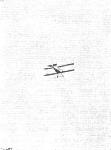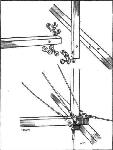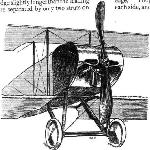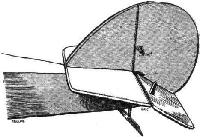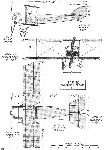C.Andrews, E.Morgan Supermarine Aircraft since 1914 (Putnam)
Pemberton Billing
<...>
Billing was hardly the man to be satisfied with producing other people’s designs such as the S.38 and proceeded to the rapid evolution of a private-venture single-seat scout of simple construction, which has become legendary as the ‘Seven Day Bus'. It had now become obvious that Pemberton Billing used the exercise of designing and building a small aeroplane of this type to create a political lever capable of influencing the sensitive emotions of the British public during the confusions of a democracy going to war. In fact, he did parade the aeroplane around his campaign area when standing for Parliament during by-elections, when his plan was to demolish the War Office aviation policy of the day, aided and abetted by C. G. Grey.
Under the stress of the time, exaggerations were probably excusable and so PB must be accorded the licence of his contemporary statements, such as that he did the drawings himself in a day and that the machine was built from scratch within seven days and so on. A great deal of research has been done by Philip Jarrett, an aeronautical writer, into the real truth about the P.B.9, as the aeroplane was first classified, and the facts disclose that Billing had at least a lap start when his rush programme was initiated. E. C. Gordon England has said since that in the effects of the then defunct Radley-England enterprise, which had been making ‘waterplanes’, was a set of wings complete, intended for a small pusher aeroplane designed by himself and which were bought by Pemberton Billing.
This purchase of redundant aircraft parts from Radley-England is confirmed in the balance sheet of Pemberton Billing Limited, dated December 1914. It was a comparatively simple matter to design a straightforward fuselage and tail unit to match the Gordon England wings, particularly as these were of one-piece design. The fuselage in fact merely rested on the bottom wing and was attached by U bolts, the inner struts standing proud of the body, there being no orthodox centre section. A reproduction of the P.B.9 fuselage drawing shows that it was done by C. Vasilesco which seems to dispose of PB's claim that he did the drawings himself or that the whole design was done on the factory walls, apart probably from a rough scheme. The structure appears to have been of the braced mortise and tenon type, the sort of thing that could have been produced in any reputable joiner’s shop. This was in fact Billing's idea, namely quick reproduction by furniture makers and so on.
In the event, the P.B.9 performed creditably on its first test flight on 12 August. 1914, in the hands of Victor Mahl and it had a reported top speed of 78 mph and a climb of 500 ft/min. No order resulted but the one example served as a naval trainer at Hendon. The internal history of the Woolston Works here becomes misty, for because of uninterested official reaction to his Seven Day Bus, PB went off in a huff to do some service with the naval air arm and left Woolston in the charge of Hubert Scott-Paine, an up-and-coming young man with red hair. How much control the founder actually retained can only be a matter of conjecture but it became clear that Scott-Paine and the Air Department of the Admiralty gradually came more and more into the picture while PB himself became absorbed in his various political crusades. With his election as member of Parliament for East Herts on 10 March, 1916, Pemberton Billing gave up his interests in the company and a new one was formed as the Supermarine Aviation Works Limited.
<...>
P.B.9 - One 50 hp Gnome. Single seat.
Span 26 ft (7-9 m); length 20 ft (5-09 m); height 8 ft 3 in (2-51 m); wing area 205 sq ft (19-04 sq m).
Empty weight 560 lb (254 kg); loaded weight 750 lb (340 kg).
Maximum speed 78 mph (125-5 km/h); climb 540 ft/min (164 m/min); duration 3 hr.
Показать полностью
M.Goodall, A.Tagg British Aircraft before the Great War (Schiffer)
Deleted by request of (c)Schiffer Publishing
PEMBERTON BILLING biplane PB.9 (PB.13)
This scout type biplane was constructed in August 1914 at the time of the outbreak of war. It was produced in a hurry, on an initiative by Billing, and became known as 'the Seven Day Bus', from its construction between the 3rd and 11th of August. On the 12th, it was taken to a field at Netley, where after repair of damage caused while taxiing, it was flown by Victor Mahl of Sopwith's. Thereafter it was transferred to Brooklands, where it was flown by Jack Alcock, who refused to fly it again after two flights. Billing then attempted to take off himself, but damaged the undercarriage before becoming airborne.
The machine was taken over by the RNAS in early 1915 and became serial No. 1267 at Hendon and Chingford, until struck off charge in June. Billing acquired the discarded PB.9 and used it to further his unsuccessful election campaign of early 1916.
The machine was comparable to other scout biplanes of the period, such as the Sopwith Tabloid and Martinsyde S.l, but it had nothing to commend it for general use, so was not ordered in quantity. A proposed enlarged version with staggered wings (PB. 17) was not built.
One feature, which was unusual, was the construction of the complete wing assembly in one unit, which was passed over the tail to its correct position, where it was then clamped to the longerons. This feature may have stemmed from an original set of wings, bought by Billing from Radley, made for the Radley-England pusher biplane, which was not completed.
The engine was the Gnome originally used in the Farman, on which Billing had learnt to fly in 1913, and was also used in the PB. 1 flying boat, which had been discarded by this time.
Power: 50hp Gnome seven-cylinder air-cooled rotary driving a 8ft diameter propeller
Data
Span 26ft
Chord 4ft 6in
Gap 4ft 6in
Area 205 sq. ft
Area tailplane 13 sq. ft
Area elevators 11 sq. ft
Area fin 2 sq. ft
Area rudder 6 sq. ft
Weight 560 lb.
Weight allup 750 lb.
Length 20 ft
Speed range 40-75 mph
Endurance 3hr
Показать полностью
P.Lewis The British Fighter since 1912 (Putnam)
The sense of urgency which rose above all other considerations manifested itself in many ways on the home front. One of those who were immediately affected was the remarkable Noel Pemberton Billing who, after several years of experimenting with various landplane designs, had veered towards the development of marine aircraft. Always a thinker on extremely original, but at the same time practical, lines of approach he had, in June, 1914, finally formed a limited company under his name at Woolston, Southampton, to manufacture his designs. As soon as war became inevitable, Pemberton Billing drew up at top speed his concept of a single-seat scout and built the machine at once. To enable it to be produced quickly in the necessary quantities envisaged, the P.B.9 was designed on lines of the utmost simplicity around the 50 h.p. Gnome engine. The sole prototype was rushed through the works at the beginning of August to completion in eight days, out of which the actual construction took a week, after which phenomenal performance it was known naturally as the Seven-Day Bus.
The P.B.9’s appearance could not have been less like that of its immediate predecessor, the P.B.7 single-seat flying-boat, the sleek lines of which made the machine one of the most advanced in design practice at the 1914 Olympia Aero Show. The box-like fuselage of the Seven-Day Bus exhibited stark utility in its form in sharp contrast with the exquisite contours of the P.B.7’s hull. The 26 ft. span wing panels of the P.B.9 bore out the theme of unrestrained simplicity, being square-cut, of constant chord and each in one piece. The lower set were taken straight across underneath the fuselage to be bolted direct to it. On the power of a 50 h.p. Gnome Victor Mahl flew the P.B.9 at Hendon, where it was successful enough to spend its life as a trainer for R.N.A.S. pilots. Even though the R.F.C. and R.N.A.S. were so critically short of scouts when they were plunged into war, Pemberton Billing’s remarkably inspired effort at filling the gap so adroitly was wasted as the machine was not ordered into production. Although this was the case, the little P.B.9 scout deserves a corner to itself in the annals of fighter development as one of the very earliest examples of the inexpensive, quickly-built, utility type which came to be known in later years as the light fighter.
Показать полностью
F.Mason The British Fighter since 1912 (Putnam)
Pemberton-Billing P.B. 9
Noel Pemberton Billing, the colourful aviation pioneer who had developed a fully-equipped aerodrome in Essex before any manned aeroplane had achieved sustained, powered flight in Britain - and had himself later gained his Royal Aero Club pilot’s Certificate after only four hours’ tuition, started the design of marine aircraft in September 1913 in a small factory he acquired at Woolston, Southampton; as evidence of his faith in these aircraft he adopted the word ‘Supermarine’ as his telegraphic address. The Pemberton-Billing P.B.1 flying boat was shown at Olympia in March 1914.
As soon as the War started in August that year he turned his attention to the design of a small single-seat tractor scout and completed the work in a single day. Simplicity of manufacture was the keynote of this aircraft, termed the P.B.9, its 50hp Gnome rotary being mounted within ply panels which avoided the use of compound curves, while the wings featured no dihedral and no stagger. Construction of the aircraft was completed within one week, giving rise to the nickname ‘Seven Day Bus’. There were no centre section struts, the inboard pairs of interplane struts being attached to upper and lower wings close to the fuselage, so that the aircraft was, in effect, a one-and-a-half-bay biplane.
The P.B.9 was first flown in August by Victor Mahl (who had tuned Howard Pixton’s winning Sopwith Tabloid for the 1914 Schneider Trophy race, and had only learned to fly at Brooklands in May that year). The aircraft was almost certainly fairly tricky to fly, and was probably never fitted with any armament. It was not selected for purchase by the Services, but was later used by the RNAS for training at Hendon, being allocated the naval serial number 1267.
Type: Single-engine, single-seat biplane scout.
Manufacturer: Pemberton-Billing Ltd., Woolston, Southampton
Powerplant: One 50hp Gnome seven-cylinder rotary driving 8ft diameter wooden propeller.
Structure: All-wood box structure with ash longerons, covered with ply and fabric. Wings of twin ash spar construction built as single components, the lower wing spars passing beneath the fuselage.
Dimensions: Span, 26ft 6in; length, 20ft 0in; wing area, 205 sq ft.
Weight: Tare, 560lb.
Performance: Max speed, 78 mph at sea level; initial rate of climb, 500 ft/min; range, approx 150 miles.
Armament: None fitted.
Prototype: One (first flown by Victor Mahl in August 1914); later allocated No 1267 (naval). No production.
Показать полностью
J.Bruce British Aeroplanes 1914-1918 (Putnam)
Pemberton-Billing P.B.9
THE name of Noel Pemberton-Billing has already appeared in this book as the planner of the raid on the Zeppelin sheds at Friedrichshafen, made on November 21st, 1914, by three Avro 504s of the R.N.A.S.
Eleven years earlier, Pemberton-Billing had begun practical experiments in aeronautics. In 1903 he designed a man-lifting kite which was completed in the following year, and in 1905-6 he designed and made a valveless rotary petrol engine with a view to applying power to his kites. Until 1909 he experimented with several peculiar monoplanes which were only partially successful, and thereafter abandoned his aeronautical activities until September, 1913. He then began the design and construction of marine aircraft in the small factory he had taken over at Woolston.
His designs all displayed startling originality of thought and application, and as evidence of his faith in the future of marine aircraft he coined the name “Supermarine” as his telegraphic address. The first aircraft to bear that name was the Supermarine P.B.1, a biplane flying boat which was displayed at the Olympia show in March, 1914. In June, 1914, the business became a limited company, known as Pemberton-Billing Ltd. Two months later Britain was at war.
Such was Pemberton-Billing’s belief in the air and such the vitality of his thought that he immediately conceived the idea of a speedy single-seater for scouting purposes, which could be built quickly and easily in order to help provide the large number of aeroplanes that he believed would turn the war in the Allies’ favour at an early date.
The new type was designated P.B.9, although it seems to have been Pemberton-Billing’s thirteenth design for a power-driven aircraft. From the commencement of design work until completion only eight days elapsed; of that period the construction occupied seven days. The P.B.9 was (for obvious reasons) nicknamed the “Seven-Day Bus”.
It was a thoroughly conventional single-bay biplane, simple in construction and appearance. Typical of its simplicity was the shape of the engine cowling: this curved in one plane only, in conformity to the shape of the upper longerons as they curved downwards to the forward bearing for the 50 h.p. Gnome engine. The fuselage was wide enough to accommodate an 80 h.p. Gnome but none was available. The output of the rather old 50 h.p. Gnome was very nominal, yet the P.B.9 performed remarkably well with it.
The interplane bracing was unusual, for there were no conventional centre-section struts. Their place was taken by full-length interplane struts placed close up against the fuselage sides. Each mainplane was made in one piece, and the spars of the lower wing ran under the fuselage. The attachment of the lower wing to the bottom longerons was of stark simplicity: four U-bolts were used, and by undoing them the wings could be instantly removed for replacement or transport.
The P.B.9 was first flown in August, 1914, by Victor Mahl. The type was not adopted, but it was later bought by the Admiralty and was used for training purposes by the R.N.A.S. at Hendon.
SPECIFICATION
Manufacturers: Pemberton-Billing, Ltd., Woolston, Southampton.
Power: 50 h.p. Gnome.
Dimensions: Span: 26 ft. Length: 20 ft. Chord: 4 ft 6 in. Gap: 4 ft 6 in. Stagger: nil. Dihedral: nil. Span of tail
8 ft 3 in. Wheel track: 4 ft 6 in. Airscrew diameter: 8 ft.
Areas: Wings: 205 sq ft. Tailplane: 13 sq ft. Elevators: 11 sq ft. Rudder: 6 sq ft.
Weights: Empty: 560 lb.
Performance: Maximum speed: 78 m.p.h. Initial rate of climb: 500 ft per min. Endurance: 3 hours.
Service Use: Used for training purposes by the R.N.A.S. at Hendon.
Показать полностью
O.Thetford British Naval Aircraft since 1912 (Putnam)
PEMBERTON-BILLING P.B.9
This little single-seat scout was designed and built in the surprisingly short time of eight days, and it made its first flight in August 1914. It was not produced in quantity, but the prototype was purchased by the Admiralty and served for a time as a trainer at the RNAS flying school at Hendon. One 50 hp Gnome rotary engine. Maximum speed, 78 mph. Climb, 500 ft/min. Endurance, 3 hr. Span, 26 ft. Length, 20 ft.
Показать полностью
Журнал Flight
Flight, August 21, 1914.
THE P.B.IX SCOUTING BIPLANE.
HITHERTO, Mr. Pemberton Billing has confined his attention to the production of seaplanes, but, as mentioned briefly in "Eddies" last week, realising the need at the present time for military biplanes for scouting work, he set to work with commendable enterprise to produce such a machine, capable of being quickly erected and dismantled for transport, and in which the engine might be exchanged for another one of different horse-power in the shortest possible space of time.
In the extraordinarily short period of one week, the designing, construction and finishing of this machine had been completed. The machine would have been put through its trial flights within that time limit but for the fact that there is no suitable ground in close proximity to the supermarine works of Mr. Pemberton Billing at Southampton. As it was, it was tested in the air within the next two or three days, and came well up to its designer's anticipations.
In its general lay-out the P.B. IX Scouting biplane does not differ materially from already existing machines of that type, but its designer has managed to incorporate several cleverly thought out details in the construction. The fuselage, which is of rectangular section, is extremely roomy, and tapers to a vertical edge at the rear. The longerons, which are of ash, converge towards the nose of the machine (when viewed from the side), where they are attached to the front engine bearer. As seen in plan, they run parallel up to the pilot's seat, whence they commence to taper gradually towards the rear. As shown in one of the accompanying sketches, the method of joining struts and cross-members to the longerons of the fuselage is similar to that employed in the Morane monoplanes, and the sketches are self-explanatory.
Mounted between double bearings in the nose of the machine is the engine - a 50 h.p. Gnome is at present fitted, but the fuselage is wide enough to accommodate an 80 if desired - and to the rear of that inside the aluminium cowl in front of the pilot's seat are the petrol and oil tanks, which have a capacity sufficient for a three hours' flight.
In its present form the machine is essentially a single-seater, but the roomy cockpit affords ample accommodation should it be desired to fit an extra seat. Control is by means of a hand wheel mounted on a single central tubular column. Behind the pilot's seat is a transverse rocking shaft, carrying at its ends crank levers from where cables run to corresponding levers on the elevator. Another steel tube connects the vertical control lever with the lower half of the crank-lever on the transverse shaft, thus doing away with crossing of the elevator control cables, which might lead to wear and subsequent breakage.
A fiat non-lifting tail plane is mounted on top of the fuselage and to it is hinged the divided elevator. Pivoted round the tubular extension of the sternpost of the fuselage is the rudder, and a vertical fixed tail fin is fitted. A small sprung tail skid protects the tail plane against contact with the ground.
The main planes are characterised by having their trailing edge slightly longer than the leading edge. They are separated by only two struts on each side, and cross bracing is effected by means of stranded cables. Ailerons are fitted to both upper and lower planes, and are inter-connected by a strut running from the under surface of the upper aileron to the top of the lower one. They are operated by rotation of the hand wheel, and steering is effected by means of a pivoted foot-bar. Near the fuselage the trailing edge has been cut away in order to provide a better view in a downward direction. It is in their attachment to the fuselage, however, that the main planes are chiefly interesting. The spars on both planes run right through the wing from tip to tip, those of the lower plane running underneath the fuselage, to the lower longerons of which they are attached by U-bolts. By undoing these four U-bolts, the wings may be slid over the end of the fuselage and laid on top, and the machine is then ready for transport. This method of attaching the wings has the further advantage that should it be desired to fit an engine of a different horse-power and weight, the longitudinal stability of the machine can be corrected by sliding the wings a few inches backwards or forwards along the fuselage. This feature should be of considerable merit for military purposes, where an interchange of engines may frequently be desirable. Another reason why the light single-seater scout should be useful for military purposes at present is that there are probably a great number of 50 h.p. Gnomes available, fitted to school machines, which would be of no use as military machines, but the engines of which could with advantage be used in a small fast machine of this class.
The chassis is of simple type, and consists of two "V's" of streamlined wood. The axle works in slots in the angle between the front and rear chassis struts. No skids are fitted. The weight of the machine empty is 560 lbs., and with pilot and three hours' fuel, 750 lbs., or a loading of 3-6 lbs. per square foot. The maximum speed with a 50 h.p. Gnome is about 75 miles per hour, and the minimum speed just over 30 miles per hour.
During the preliminary trials a few days ago, already mentioned, P.B. IX got off after a very short run, piloted by Mr. V. Mahl, and appeared to climb at the rate of about 500 ft. per minute.
Показать полностью







